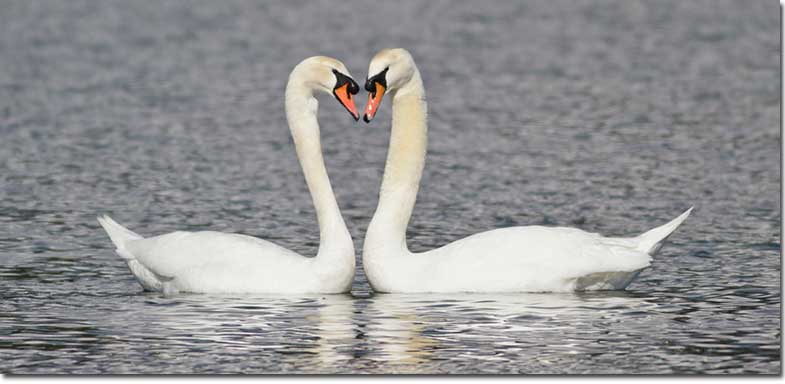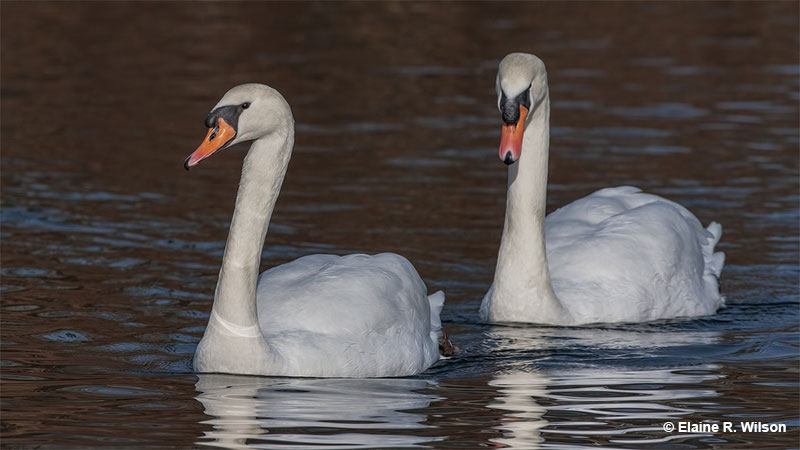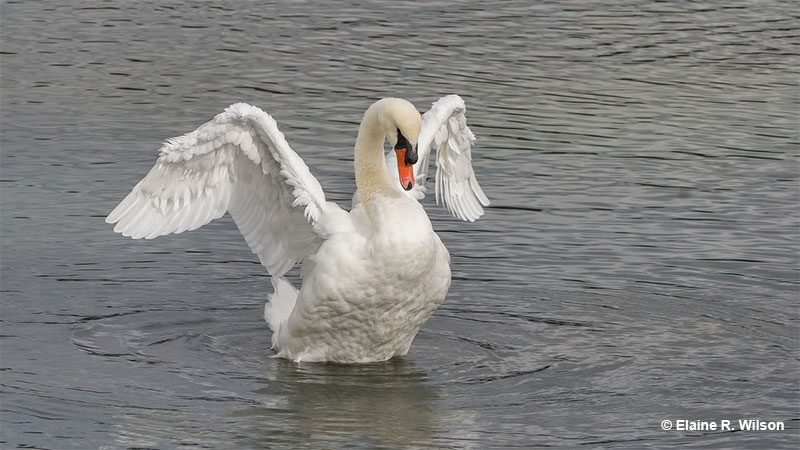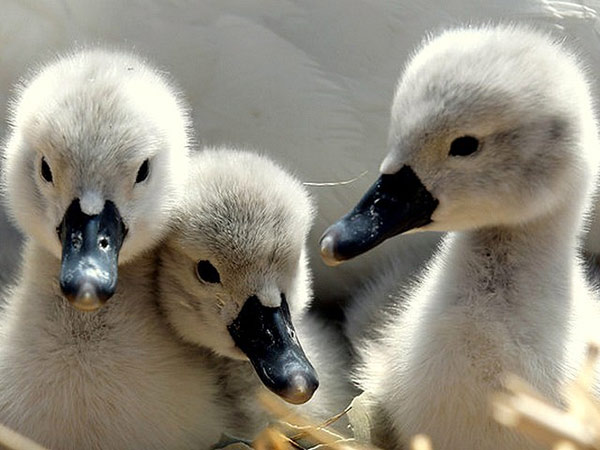
Female swans are very large birds. They’re a part of the Anatidae family, which is a biological family that includes swans, ducks, and geese.
Additionally, swans are considered to be waterfowl. Waterfowl are birds that have webbed feet and broad, flat bills.
Swans are very intelligent birds and can remember those who have been kind and those who have not. Female swans are called Pens; this comes from how females fold their wings back in a penned manner.
The name comes from the English term “Penne.”
Key takeaways:
- Female swans are known to have thinner necks.
- For Mute Swans, males have a black hump on their bills, which changes in size during breeding season.
- Female swans are not as vocal as males, but are fierce protectors of their younglings.
On this page
How to Identify a Female Swan
It’s hard to tell if you’re looking at a male or female swan from a distance. However, the good news is that there are ways for you to tell the sex of the bird you’re looking at if you can get a closer look. For the sake of clarity, we will be mainly focusing on Mute Swans (Cygnus olor).
There are other swan species in North America – Trumpeter Swans (Cygnus buccinator), Tundra Swans (Cygnus columbianus, sometimes called the Whistling Swan or Bewick’s Swan), and even Black Swans (Cygnus atratus), but they are not quite as widespread as Mute Swans.
The only other species breeding in the United States is the Trumpeter Swan, so it is possible to see some Trumpeter Swan cygnets if you are lucky, but Tundra Swans breed in tundra.
When it comes to swan identification, Black Swans are the easiest to identify. However, they are native to Australia, and there is a limited population in the U.S.
When it comes to Mute Swans, male and female swans have over 25,000 white feathers on their bodies and are almost identical in looks and size.
However, male swans have a black knob or a bump, called a blackberry, at the base of their bill that swells during breeding season. This makes it easier to identify who’s who; however, you’ll be happy to know that outside of breeding season, the bump is still more prominent on males; it’s just not as noticeable.
Additionally, you can look at the necks of the swans. Female swans have thinner necks.

Female swans can be identified by their necks (they generally have thinner necks).
Call
Female swans tend to be a little bit quieter than male swans. Male swans have muffled, hoarse, trumpet-like calls. They make these calls during territorial defense.
Additionally, swans make an escalating hissing or snorting when disturbed or threatened. Mates will greet each other with a snoring sound. Female swans will seek their mates with a deliberate glock, glock call.
Female swans will call their broods with a sound that sounds like a yapping puppy. They are also known to slap the water with their feet to alert to potential intruders. They’ll either strike the water simultaneously or alternately.
Relations
Female swans have short legs that sit far back on their bodies. This can give them an awkward walk; however, don’t let that fool you. These birds can run and can take off from land and water fast. Swans can run as fast as 22 miles per hour and fly anywhere from 18 to 30 miles per hour.
On the water, these birds are seen holding their wings out and slightly raised to “sail” in the wind. Female swans mate with one male for life. However, if the male dies or they lose cygnets, she’ll find another mate.
Swans are relatively comfortable around humans, making them peaceful creatures most of the time. However, these birds can be very aggressive when defending their territory during breeding season.

This could be because they feel threatened or are protecting their young.
While physical attacks on humans are uncommon, they can be dangerous due to the speeds they can reach. If another swan were to approach a mated pair, they’ll raise their wings and tuck their neck to warn the unwelcomed guest off.
Swans have also been known to chase off geese, ducks, gulls, humans, and dogs. These birds’ enormous appetites and aggressive nature of these birds can create a problem for wildlife managers.
In addition, swans displace native species from foraging and breeding sites and can cause damage to habitats by overgrazing. However, they do like to give each other high-fives! Once they successfully scare off those from their territory they’ll call to each other in celebration and flap their wings.
Swans prefer aquatic habitats, coastal estuaries, farm ponds, and urban lakes. From New England south to Virginia and in the Pacific Northwest, mated pairs will choose saltwater, fresh, and brackish ponds for breeding.
If they settle more inland, swans will breed on bogs, slow-moving rivers, creeks, streams that empty into large lakes, embayments, and other bodies of water.
Lifecycle of Female Swans
Swans can live up to 20 to 30 years. This range is for wild swans. Of course, pet and farm-raised swans can live longer. Both adult swans and younglings are prey to mink and foxes. However, Cygnets have more predators. These birds are mainly prey to herons, crows, magpies, pike, large perch, and turtles.

Male swans are the ones to pick the nesting site. They may even start a number of nests before the female welcomes the location.
Nest sites are built in safe places from flooding, but they’re close enough to water where the parents will have easy access. This allows them to acquire food and nesting materials easily.
Male swans will start by building a platform of crisscrossed vegetation. Then, he’ll place greenery next to the platform for his mate to pile onto the base of the nest. Next, the female will use her feet and body to mold a cup in the nest.
Nesting materials include reeds, twigs, cattails, sedges, cordgrasses, rushes, pebbles, and bulrushes. In addition, the cup can contain some down and rotting vegetation. When the nest is finished, it’ll be 5 feet wide and 1.5 – 2.1 feet tall.
The cup will be 15 inches wide and have a depth of 3 – 10 inches. Completion takes about 10 days, and the mated pair may continue to add materials to the nest during egg laying and brooding. The female lays a clutch of eggs, usually anywhere from 2-5 eggs. In other species, like Trumpeter Swans, this number can grow to six.
Mute Swans incubate their eggs for a little bit longer than a month, around 37 days. Their eggs are bluish-green when they’re first laid. They’ll change to a chalky white as time goes on.
Baby swans stay with their parents until they are around 3 or 4 years old. Once they hit that age, they will leave and find a mate.
Frequently Asked Questions
What is a female swan called?
Female swans are called Pens – this comes from how females fold their wings back in a penned manner. The name comes from the English term “Penne.” Interestingly, there is a term for male swans too – they are called Cobs.
How can you tell a swan’s gender?
Male swans have a black bump, called a blackberry, at the base of their bill that’s larger than the females. Additionally, you can look at the necks of the swans. Female swans have thinner necks.
Are white swans male or female?
White swans can be both male or female.
Do swans have one mate for life?
Swans are monogamous birds that can spend a lifetime with a single mate. However, swans have found a new mate for various reasons like the death of their babies or their mate.
How long do female swans live?
Female swans can live up to 20 to 30 years.
How long do swans stay with their mother?
Cygnets, or simply baby swans, will stay with their mothers for 5 to 10 months.


Philip letts
Tuesday 13th of June 2023
How long or to what age are female swans fertile.
Patrick O'Donnell
Monday 19th of June 2023
@Philip- Female swans become fertile when they are three years old. They stay fertile for most of the rest of their life. Depending on the species, this can be 30 years or more.